
|
It passes only 0.05 a.u. from Sun on Aug. 31, then it will brighten up to 5.5 mag. It is not observable on the ground. But it was detected in the SOHO spacecraft's images.
Date(TT) R.A. (2000) Decl. Delta r Elong. m1 Best Time(A, h)
Aug. 31 10 30.85 9 22.7 0.949 0.064 1 6.9 4:03 (245,-18)
Sept. 7 11 17.48 3 54.4 1.326 0.333 4 14.5 19:45 (106,-16)
|
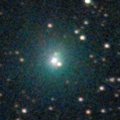
|
Now it is bright as 10.5 mag (Aug. 31, Maik Meyer). It is expected to brighten up to 8-9 mag in autumn. In the Northern Hemisphere, it stays observable for a long time while the comet is brightening. In the Southern Hemisphere, it it not observable until mid September.
Date(TT) R.A. (2000) Decl. Delta r Elong. m1 Best Time(A, h)
Aug. 31 3 20.77 55 27.8 1.000 1.457 92 10.0 4:03 (197, 68)
Sept. 7 2 42.18 52 18.6 0.821 1.455 104 9.6 3:42 (180, 72)
|
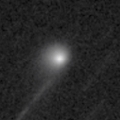
|
Now it is 12.0 mag (Aug. 31, Maik Meyer). It will brighten up to 11 mag and it will be observable in good condition from autumn to winter.
Date(TT) R.A. (2000) Decl. Delta r Elong. m1 Best Time(A, h)
Aug. 31 2 34.60 23 12.7 2.666 3.202 113 11.7 4:01 ( 0, 78)
Sept. 7 2 28.66 25 14.6 2.557 3.188 120 11.6 3:27 ( 0, 80)
|
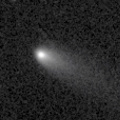
|
Now it is 12.4 mag (Aug. 31, Maik Meyer). It will brighten up to 11.5 mag in autumn. In the Northern Hemisphere, it will be observable in excellent condition. In the Southern Hemisphere, it will be extremely low from autumn to winter.
Date(TT) R.A. (2000) Decl. Delta r Elong. m1 Best Time(A, h)
Aug. 31 2 16.95 20 29.6 0.632 1.421 118 12.0 3:43 ( 0, 75)
Sept. 7 2 27.56 24 52.5 0.606 1.417 120 11.8 3:26 ( 0, 80)
|

|
It has not been observed yet in this apparition. Now it is fainter than 21.5 mag (Aug. 4, Erwin Schwab). It was expected to brighten up to 12 mag from August to September. But actually, it must be much fainter than expected. It is observable in good condition in the Northern Hemisphere. In the Southern Hemisphere, it will be unobservable in September.
Date(TT) R.A. (2000) Decl. Delta r Elong. m1 Best Time(A, h)
Aug. 31 4 50.52 37 53.0 1.118 1.391 81 11.9 4:03 (254, 63)
Sept. 7 5 13.04 40 43.7 1.109 1.411 83 11.9 4:09 (248, 65)
|

|
It brightened rapidly. Now it is very bright as 12.3 mag (Aug. 28, Chris Wyatt). It stays at 12.5 mag until September. In the Southern Hemisphere, it stays observable in the low sky until it becomes fainter than 18 mag in winter. It is not observable at all in the Northern Hemisphere.
Date(TT) R.A. (2000) Decl. Delta r Elong. m1 Best Time(A, h)
Aug. 31 9 5.12 -37 56.3 1.920 1.511 51 12.4 4:03 (300,-25)
Sept. 7 9 32.35 -43 12.7 1.917 1.546 53 12.7 4:09 (306,-26)
|
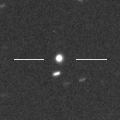
|
Now it is 13.8 mag (Aug. 28, Chris Wyatt). It is expected to brighten up to 8 mag in 2020.
Date(TT) R.A. (2000) Decl. Delta r Elong. m1 Best Time(A, h)
Aug. 31 5 19.07 22 33.8 3.543 3.450 76 12.9 4:03 (278, 53)
Sept. 7 5 24.04 23 31.3 3.371 3.383 82 12.7 4:09 (283, 59)
|
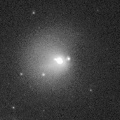
|
Now it is 13.8 mag (Aug. 28, Chris Wyatt).
Date(TT) R.A. (2000) Decl. Delta r Elong. m1 Best Time(A, h)
Aug. 31 0 57.13 16 19.9 4.996 5.773 136 13.2 2:23 ( 0, 71)
Sept. 7 0 54.92 16 17.9 4.930 5.773 143 13.2 1:54 ( 0, 71)
|

|
Appearing in the morning sky. It is observable at 14 mag in good condition in autumn.
Date(TT) R.A. (2000) Decl. Delta r Elong. m1 Best Time(A, h)
Aug. 31 7 48.48 16 28.7 3.007 2.344 41 13.8 4:03 (263, 19)
Sept. 7 8 1.05 15 43.3 2.976 2.371 44 13.9 4:09 (267, 23)
|
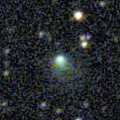
|
Now it is 13.3 mag (Aug. 28, Chris Wyatt). It is observable at 13.5 mag in good condition in autumn.
Date(TT) R.A. (2000) Decl. Delta r Elong. m1 Best Time(A, h)
Aug. 31 17 31.91 -9 41.7 1.398 1.930 105 13.9 19:57 ( 21, 43)
Sept. 7 17 40.56 -10 44.1 1.436 1.905 100 13.8 19:45 ( 23, 41)
|

|
Now it is 14.0 mag (Aug. 28, Chris Wyatt). It stays 13-14 mag for a long time in 2019. In the Southern Hemisphere, it is observable in excellent condition. In the Northern Hemisphere, it is not observasble until summer in 2020.
Date(TT) R.A. (2000) Decl. Delta r Elong. m1 Best Time(A, h)
Aug. 31 8 59.56 -67 28.9 3.087 3.047 78 13.9 4:03 (333,-34)
Sept. 7 9 12.36 -70 2.6 3.092 3.056 78 13.9 4:09 (336,-33)
|

|
It brightened up to 7.7 mag in June in 2018 (June 19, Juan Jose Gonzalez). Now it is fading. It has already faded down to 14.3 mag (Aug. 24, Thomas Lehmann). In the Southern Hemisphere, it stays observable for a long time until the comet will fade out. In the Northern Hemisphere, it will appear in the morning sky in late September. But it stays low for a while after that.
Date(TT) R.A. (2000) Decl. Delta r Elong. m1 Best Time(A, h)
Aug. 31 6 58.53 -29 26.2 4.969 4.628 64 14.3 4:03 (308, 1)
Sept. 7 7 1.02 -29 50.1 4.972 4.685 67 14.4 4:09 (313, 6)
|
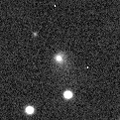
|
Now it is 14.0 mag (Aug. 28, Chris Wyatt). In the Southern Hemisphere, it is observable for a long time. It stays low in the Northern Hemisphere.
Date(TT) R.A. (2000) Decl. Delta r Elong. m1 Best Time(A, h)
Aug. 31 23 48.94 -45 45.1 3.496 4.317 139 14.8 1:16 ( 0, 9)
Sept. 7 23 40.58 -45 20.7 3.521 4.342 140 14.8 0:40 ( 0, 10)
|
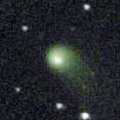
|
Now it is 14.8 mag (Aug. 28, Chris Wyatt). It will be fading slowly after this. It is observable in excellent condition in the Southern Hemisphere. It will never be observable after this in the Northern Hemisphere.
Date(TT) R.A. (2000) Decl. Delta r Elong. m1 Best Time(A, h)
Aug. 31 13 35.12 -43 20.2 4.171 3.878 66 15.0 19:57 ( 46,-14)
Sept. 7 13 36.83 -43 47.2 4.296 3.913 61 15.1 19:45 ( 47,-16)
|
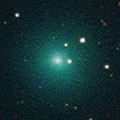
|
It brightened rapidly up to 10 mag in June. Now it is not observable. It will appear in the morning sky in October. But it will be fainter than 18 mag at that time.
Date(TT) R.A. (2000) Decl. Delta r Elong. m1 Best Time(A, h)
Aug. 31 10 4.96 13 54.2 2.782 1.791 8 15.3 4:03 (246, -9)
Sept. 7 10 13.52 10 58.1 2.830 1.859 12 15.8 4:09 (252, -6)
|
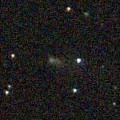
|
Now it is 16.2 mag (Aug. 9, Charles Morris). It is observable at 16 mag in good condition from summer to autumn. It locates somewhat low in the Southern Hemisphere.
Date(TT) R.A. (2000) Decl. Delta r Elong. m1 Best Time(A, h)
Aug. 31 3 27.29 26 42.7 1.654 2.093 100 15.9 4:03 (304, 76)
Sept. 7 3 34.51 27 24.0 1.598 2.109 105 15.9 4:09 (325, 81)
|
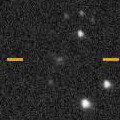
|
Now it is 15.0 mag (July 21, iTelescope Observatory, Siding Spring). It stays 16 mag for a long time from 2019 to 2020. It is observable in excellent condition in the Southern Hemisphere. It is hardly observable in the Northern Hemisphere.
Date(TT) R.A. (2000) Decl. Delta r Elong. m1 Best Time(A, h)
Aug. 31 11 17.39 -56 24.7 3.841 3.551 65 15.9 19:57 ( 42,-39)
Sept. 7 11 23.33 -57 30.1 3.859 3.535 64 15.9 19:45 ( 41,-40)
|
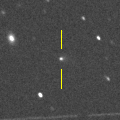
|
Now it is 17.5 mag (Aug. 26, Toshihiko Ikemura, Hirohisa Sato). It will brighten up to 15.5 mag and it will be observable in good condition in autumn.
Date(TT) R.A. (2000) Decl. Delta r Elong. m1 Best Time(A, h)
Aug. 31 0 5.67 -6 28.7 1.649 2.611 157 16.1 1:32 ( 0, 49)
Sept. 7 0 3.25 -7 3.8 1.601 2.586 164 16.0 1:02 ( 0, 48)
|
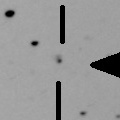
|
It looks cometary on the LCO (CTIO) image on Aug. 21. Now it is 15.9 mag (Aug. 8, ATLAS-MLO, Mauna Loa). It is observable in excellent condition in the Southern Hemisphere. In the Northern Hemisphere, it locates extremely low for a while.
Date(TT) R.A. (2000) Decl. Delta r Elong. m1 Best Time(A, h)
Aug. 31 20 31.96 -42 54.7 5.646 6.418 136 16.0 21:54 ( 0, 12)
Sept. 7 20 23.38 -42 36.4 5.724 6.417 129 16.0 21:18 ( 0, 12)
|
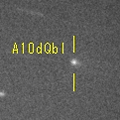
|
Now it is 15.8 mag (Aug. 26, Toshihiko Ikemura, Hirohisa Sato). It stays observable in good condition while the comet will be fading slowly after this.
Date(TT) R.A. (2000) Decl. Delta r Elong. m1 Best Time(A, h)
Aug. 31 3 15.49 8 50.6 1.663 2.195 107 16.0 4:03 (339, 62)
Sept. 7 3 22.19 8 0.4 1.629 2.228 113 16.0 4:09 (354, 63)
|
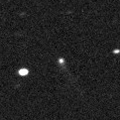
|
Now it is 16.2 mag (Aug. 10, Ken-ichi Kadota). It stays 15-16 mag for a long time until 2021.
Date(TT) R.A. (2000) Decl. Delta r Elong. m1 Best Time(A, h)
Aug. 31 20 43.44 -32 57.6 4.192 5.051 144 16.1 22:06 ( 0, 22)
Sept. 7 20 34.95 -32 13.9 4.237 5.025 137 16.1 21:30 ( 0, 23)
|
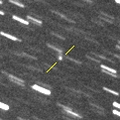
|
Now it is 16.5 mag (July 27, Kevin Hills). It will brighten up to 14 mag in winter. It stays observable for a long time in the Southern Hemisphere. In the Northern Hemisphere, it is not observable for a long time until August in 2020.
Date(TT) R.A. (2000) Decl. Delta r Elong. m1 Best Time(A, h)
Aug. 31 14 53.07 -38 41.9 2.859 2.800 76 16.3 19:57 ( 40, 0)
Sept. 7 14 52.83 -39 34.8 2.913 2.746 70 16.2 19:45 ( 41, -3)
|

|
First return of a new periodic comet which brightened up to 16.5 mag in 2009. It has not been recovered yet in this apparition. It will brighten up to 16 mag in autumn. It is observable in good condition in the Northern Hemisphere. It locates low in the Southern Hemisphere.
Date(TT) R.A. (2000) Decl. Delta r Elong. m1 Best Time(A, h)
Aug. 31 6 29.27 26 52.2 1.420 1.275 60 16.3 4:03 (263, 40)
Sept. 7 6 58.07 25 35.0 1.406 1.269 60 16.3 4:09 (265, 41)
|
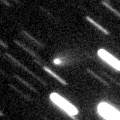
|
Peculiar asteroid moving along a cometary orbit. Now it is bright as 16.6 mag (Aug. 29, Roberto Haver and Roberto Gorelli). Roberto Haver reported its cometary activity was detected. It is observable at 15.5 mag in good condition in autumn.
Date(TT) R.A. (2000) Decl. Delta r Elong. m1 Best Time(A, h)
Aug. 31 6 12.19 23 14.8 2.670 2.410 64 16.5 4:03 (269, 42)
Sept. 7 6 7.14 22 26.7 2.525 2.415 72 16.3 4:09 (276, 50)
|

|
It approached to Earth down to 0.3 a.u. in mid February, and brightened up to 5.5 mag (Feb. 13, Juan Jose Gonzalez). Now it is fading. It has already faded down to 16.9 mag (Aug. 23, Thomas Lehmann).
Date(TT) R.A. (2000) Decl. Delta r Elong. m1 Best Time(A, h)
Aug. 31 4 19.96 41 59.8 2.924 3.041 86 16.6 4:03 (243, 69)
Sept. 7 4 9.90 42 34.9 2.862 3.114 94 16.7 4:09 (232, 76)
|
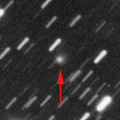
|
Now it is 16.5 mag (Aug. 22, Thomas Lehmann). It is expected to be observable at 5-6 mag for a long time from 2022 to 2023. In the Northern Hemisphere, it is not observable at the highlight from 2022 summer to 2023 summer. In the Southern Hemisphere, it stays unobservable for a while. But it will be observable in good condition at the highlight.
Date(TT) R.A. (2000) Decl. Delta r Elong. m1 Best Time(A, h)
Aug. 31 17 7.47 53 55.7 10.958 10.960 87 16.6 19:57 (148, 66)
Sept. 7 17 6.96 53 13.3 10.939 10.913 85 16.6 19:45 (143, 64)
|

|
Fading now. Now it is 15.7 mag (Aug. 5, M. Masek). In the Southern Hemisphere, it stays observable for a long time until it fades out. In the Northern Hemisphere, it will not be observable after this.
Date(TT) R.A. (2000) Decl. Delta r Elong. m1 Best Time(A, h)
Aug. 31 6 43.76 -34 12.0 5.079 4.822 69 16.6 4:03 (313, 0)
Sept. 7 6 45.07 -35 51.2 5.070 4.873 73 16.7 4:09 (319, 3)
|
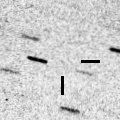
|
Peculiar asteroid moving along a cometary orbit. It approached to Earth down to 0.37 a.u. in mid August. Then it brightened up to 14.8 mag (Aug. 19, P. Camilleri, J. Oey, R. Groom). Now it is fading very rapidly.
Date(TT) R.A. (2000) Decl. Delta r Elong. m1 Best Time(A, h)
Aug. 31 17 53.22 -25 56.4 0.594 1.346 111 16.7 19:57 ( 11, 28)
Sept. 7 17 8.75 -22 4.1 0.810 1.340 94 17.5 19:45 ( 27, 28)
|
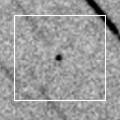
|
It passed the perihelion on July 2. Then it must have brightened up to 13 mag, but it was not observable around that time. In the Northern Hemisphere, it stays observable in excellent condition until December when it becomes fainter than 18 mag. In the Southern Hemisphere, it stays locating low.
Date(TT) R.A. (2000) Decl. Delta r Elong. m1 Best Time(A, h)
Aug. 31 4 48.70 49 11.4 0.994 1.302 81 16.7 4:03 (229, 62)
Sept. 7 4 35.69 50 51.5 0.978 1.391 88 16.7 4:09 (218, 68)
|
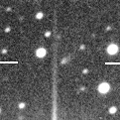
|
Now it is 16.7 mag (Aug. 7, Toshihiko Ikemura, Hirohisa Sato). It is observable at 17 mag in good condition from August to September.
Date(TT) R.A. (2000) Decl. Delta r Elong. m1 Best Time(A, h)
Aug. 31 0 47.57 22 5.2 1.595 2.417 135 16.8 2:14 ( 0, 77)
Sept. 7 0 33.65 17 15.8 1.539 2.446 147 16.8 1:33 ( 0, 73)
|
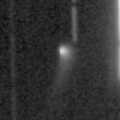
|
Now it is 16.8 mag (Aug. 2, Charles Morris). It will be fading after this. In the Northern Hemisphere, it stays observable in good condition for a long time. In the Southern Hemisphere, it stays extremely low for a long time.
Date(TT) R.A. (2000) Decl. Delta r Elong. m1 Best Time(A, h)
Aug. 31 4 4.63 49 53.4 3.818 3.916 88 16.8 4:03 (220, 68)
Sept. 7 3 56.33 49 59.6 3.729 3.951 95 16.8 4:09 (206, 73)
|

|
Now it is 18.4 mag (Aug. 1, iTelescope Observatory, Siding Spring). It will brighten up to 16 mag in autumn. It is observable in good condition in the Southern Hemisphere. It locates somewhat low in the Northern Hemisphere.
Date(TT) R.A. (2000) Decl. Delta r Elong. m1 Best Time(A, h)
Aug. 31 18 28.23 -35 46.8 1.295 1.982 118 17.1 19:57 ( 1, 19)
Sept. 7 18 33.30 -34 11.4 1.331 1.956 112 16.9 19:45 ( 4, 21)
|
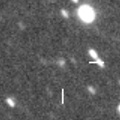
|
Now it is 17.4 mag (June 20, iTelescope Observatory, Siding Spring). It will be fading slowly after this. It is observable in excellent condition in the Southern Hemisphere. It locates low in the Northern Hemisphere.
Date(TT) R.A. (2000) Decl. Delta r Elong. m1 Best Time(A, h)
Aug. 31 14 28.19 -38 18.8 3.815 3.630 71 17.0 19:57 ( 43, -3)
Sept. 7 14 26.24 -38 14.5 3.932 3.629 65 17.1 19:45 ( 46, -5)
|
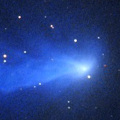
|
Now it is 17.2 mag (Aug. 26, Toshihiko Ikemura, Hirohisa Sato). Small outburst occurred in early August. But it has already faded. It is observable in good condition in the Northern Hemisphere. In the Southern Hemisphere, it stays extremely low for a while.
Date(TT) R.A. (2000) Decl. Delta r Elong. m1 Best Time(A, h)
Aug. 31 14 54.19 26 23.4 5.707 5.333 63 17.0 19:57 ( 95, 43)
Sept. 7 14 57.91 25 8.3 5.825 5.386 59 17.1 19:45 ( 95, 40)
|
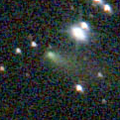
|
Now it is 16.8 mag (Aug. 2, Ken Ogawa). It is observable in excellent condition in the Northern Hemisphere. It locates extremely low in the Southern Hemisphere. It will be fading after this, and it will be fainter than 18 mag in late September.
Date(TT) R.A. (2000) Decl. Delta r Elong. m1 Best Time(A, h)
Aug. 31 1 11.88 46 16.7 1.528 2.154 114 17.1 2:38 (180, 79)
Sept. 7 1 9.74 45 28.8 1.524 2.214 120 17.3 2:08 (180, 79)
|

|
Now it is 19.4 mag (Aug. 14, Slooh.com Canary Islands Observatory). It is predicted to brighten up to 16.5 mag in winter, and it will be observable in good condition. But it is fainter than this ephemeris recently. It locates somewhat low in the Southern Hemisphere.
Date(TT) R.A. (2000) Decl. Delta r Elong. m1 Best Time(A, h)
Aug. 31 4 18.76 24 10.0 3.195 3.351 90 17.6 4:03 (289, 65)
Sept. 7 4 23.92 24 25.0 3.088 3.341 95 17.5 4:09 (299, 71)
|
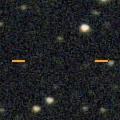
|
It was observed at 18 mag in summer in 2018. In 2019, it is predicted to brighten up to 17.5 mag, and it is be observable in good condition in autumn. But actually, it is not detected, fainter than 19.5 mag (Aug. 29, Roland Fichtl).
Date(TT) R.A. (2000) Decl. Delta r Elong. m1 Best Time(A, h)
Aug. 31 1 37.11 20 36.8 2.602 3.302 126 17.6 3:03 ( 0, 76)
Sept. 7 1 36.55 20 33.1 2.532 3.305 133 17.6 2:35 ( 0, 76)
|

|
Now it is fading. In 2019, it is observable at 17.5 mag in good condition in autumn.
Date(TT) R.A. (2000) Decl. Delta r Elong. m1 Best Time(A, h)
Aug. 31 2 56.83 11 18.5 3.598 4.083 111 17.8 4:03 (348, 66)
Sept. 7 2 56.74 11 17.3 3.518 4.097 118 17.7 3:55 ( 0, 66)
|
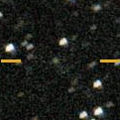
|
Now it is 17.4 mag (Aug. 26, Toshihiko Ikemura, Hirohisa Sato). It will brighten up to 12 mag in winter in 2022.
Date(TT) R.A. (2000) Decl. Delta r Elong. m1 Best Time(A, h)
Aug. 31 22 27.24 47 38.2 7.336 7.937 123 17.8 23:49 (180, 77)
Sept. 7 22 23.33 47 38.1 7.265 7.892 125 17.8 23:18 (180, 77)
|

|
Now it is 18.3 mag (Aug. 23, A. Diepvens). It will brighten very rapidly, and it will brighten up to 14 mag in winter. It is observable in excellent condition in the Northern Hemisphere. It locates low in the Southern Hemisphere.
Date(TT) R.A. (2000) Decl. Delta r Elong. m1 Best Time(A, h)
Aug. 31 2 2.45 39 44.6 1.460 2.059 111 18.1 3:28 (180, 85)
Sept. 7 2 9.02 41 18.6 1.366 2.020 115 17.8 3:07 (180, 84)
|

|
First return of a new periodic comet which brightened up to 18 mag in 2014. Now it is 20.0 mag (July 27, iTelescope Observatory, Siding Spring). It will brighten rapidly up to 17 mag in autumn. It is observable in good condition in the Northern Hemisphere. It locates extremely low in the Southern Hemisphere.
Date(TT) R.A. (2000) Decl. Delta r Elong. m1 Best Time(A, h)
Aug. 31 2 10.86 11 31.8 0.347 1.232 122 18.2 3:36 ( 0, 66)
Sept. 7 2 43.30 17 14.2 0.316 1.198 120 17.9 3:41 ( 0, 72)
|

|
It has not been observed yet in this apparition. It was expected to be observable at 17.5 mag from June to August. But actually, it was fainter than 21.5 mag in March (Mar. 10, Erwin Schwab).
Date(TT) R.A. (2000) Decl. Delta r Elong. m1 Best Time(A, h)
Aug. 31 18 39.41 -22 12.9 1.372 2.091 122 17.9 20:03 ( 0, 33)
Sept. 7 18 45.38 -23 3.6 1.440 2.095 116 18.0 19:45 ( 1, 32)
|

|
First return of a new periodic comet which brightened up to 17 mag in 2006. It has not been recovered yet in this apparition. It will brighten up to 18 mag in autumn. It is observable in good condition in the Southern Hemisphere. It locates extremely low in the Northern Hemisphere.
Date(TT) R.A. (2000) Decl. Delta r Elong. m1 Best Time(A, h)
Aug. 31 16 44.49 -37 2.3 2.227 2.558 97 17.9 19:57 ( 22, 14)
Sept. 7 16 53.55 -36 40.2 2.289 2.540 92 17.9 19:45 ( 23, 13)
|

|
Now it is bright as 17 mag (Aug. 23, Hidetaka Sato). Hidetaka Sato reported it looks cometary with coma. It will be getting lower gradually after this.
Date(TT) R.A. (2000) Decl. Delta r Elong. m1 Best Time(A, h)
Aug. 31 17 50.25 -10 48.8 4.178 4.621 109 19.5 19:57 ( 15, 43)
Sept. 7 17 51.54 -11 8.6 4.274 4.618 103 19.6 19:45 ( 19, 42)
|
|
![]()
 C/2018 W2 ( Africano )
C/2018 W2 ( Africano ) C/2018 N2 ( ASASSN )
C/2018 N2 ( ASASSN ) 260P/McNaught
260P/McNaught 168P/Hergenrother
168P/Hergenrother C/2019 A9 ( PanSTARRS )
C/2019 A9 ( PanSTARRS ) C/2017 T2 ( PanSTARRS )
C/2017 T2 ( PanSTARRS ) 29P/Schwassmann-Wachmann 1
29P/Schwassmann-Wachmann 1 78P/Gehrels 2
78P/Gehrels 2 68P/Klemola
68P/Klemola C/2018 A6 ( Gibbs )
C/2018 A6 ( Gibbs ) C/2016 M1 ( PanSTARRS )
C/2016 M1 ( PanSTARRS ) C/2017 B3 ( LINEAR )
C/2017 B3 ( LINEAR ) C/2017 M4 ( ATLAS )
C/2017 M4 ( ATLAS ) C/2018 R3 ( Lemmon )
C/2018 R3 ( Lemmon ) 261P/Larson
261P/Larson C/2018 F4 ( PanSTARRS )
C/2018 F4 ( PanSTARRS ) 101P/Chernykh
101P/Chernykh A/2017 U7
A/2017 U7 C/2019 K5 ( Young )
C/2019 K5 ( Young ) C/2019 K7 ( Smith )
C/2019 K7 ( Smith ) C/2019 K1 ( ATLAS )
C/2019 K1 ( ATLAS ) P/2008 Y1 ( Boattini )
P/2008 Y1 ( Boattini ) 2018 DO4
2018 DO4 C/2018 Y1 ( Iwamoto )
C/2018 Y1 ( Iwamoto ) C/2017 K2 ( PanSTARRS )
C/2017 K2 ( PanSTARRS ) C/2016 N6 ( PanSTARRS )
C/2016 N6 ( PanSTARRS ) A/2018 V3
A/2018 V3 (3200) Phaethon
(3200) Phaethon C/2019 K4 ( Ye )
C/2019 K4 ( Ye ) C/2018 A3 ( ATLAS )
C/2018 A3 ( ATLAS ) 160P/LINEAR
160P/LINEAR C/2018 KJ3 ( Lemmon )
C/2018 KJ3 ( Lemmon ) C/2016 R2 ( PanSTARRS )
C/2016 R2 ( PanSTARRS ) C/2019 D1 ( Flewelling )
C/2019 D1 ( Flewelling ) 203P/Korlevic
203P/Korlevic 200P/Larsen
200P/Larsen 65P/Gunn
65P/Gunn C/2019 L3 ( ATLAS )
C/2019 L3 ( ATLAS ) 114P/Wiseman-Skiff
114P/Wiseman-Skiff P/2019 O1 ( Kowalski )
P/2019 O1 ( Kowalski ) P/2012 K3 ( Gibbs )
P/2012 K3 ( Gibbs ) P/2006 H1 ( McNaught )
P/2006 H1 ( McNaught ) 2019 LD2
2019 LD2![]()
































